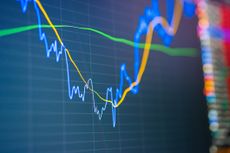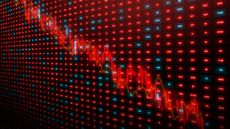Watch Out for the Final-Bell Stampede
Stocks go wild at the end of every trading day. Here's how you can take advantage of the frenzy.

Finally, a day to exhale. On Tuesday, October 28, that bucking bronco called the Dow Jones industrial average is doing okay -- at two o'clock, it's up about 125 points, in fact. I go to a meeting, take a break at 3:45, and ... what the heck? The Dow is up 675, the Nasdaq is all green, and Standard & Poor's 500-stock index is flying. The Dow was up 886 at the close, an 11% increase. In 15 minutes, stocks tacked on what is usually a calendar quarter's worth of gains, and for no obvious reason. Is it time to relax?
Not so fast. The previous day, it was the same story, only in reverse. A flat trading session dissipated into a sea of last-minute losses and cost investors in U.S. stocks $400 billion. And, of course, it was déjà vu all over again on October 29. The Dow was up about 300 points around 3:45 p.m., only to surrender 370 points in the final 15 minutes of trading.
Every day, it seems, the torture (or reward, as was the case October 28) comes at the end of trading. Mostly, the rallies have been vastly outnumbered by those recurrent three o'clock crashes.

Sign up for Kiplinger’s Free E-Newsletters
Profit and prosper with the best of expert advice on investing, taxes, retirement, personal finance and more - straight to your e-mail.
Profit and prosper with the best of expert advice - straight to your e-mail.
What in blazes is going on? The true explanation for this exaggerated and unprecedented action is a series of coincidences in the way trading takes place in this messy and undisciplined market. Randy Frederick, the director of derivatives for Charles Schwab, is one who knows the score.
There are three causes for losses (and occasional gains) late in the day, Frederick says. The first is mutual fund redemptions. Funds that are losing steadily are getting hit with redemptions -- that is, more selling than buying -- and it's occurring almost every day. The fund trading desks wait as long as they can each day to choose what to sell, and they time the sales to capture what could still be midday gains.
So the sell orders pour in late in the day, overwhelming the relatively few cash-rich American investors willing to swoop in and buy at a bargain price. The Europeans, meanwhile, are in the pubs and cafés, and the Asians are in bed. We wait until the next morning in Tokyo for any bounce-back buying (as we did first thing on October 28, before the day's trading pattern really unfolded).
Second, Frederick says, a significant number of hedge funds are still deleveraging. In other words, they are selling good assets to pay off debt that's been called -- that, or they are funding redemptions (or even going out of business). The hedge funds themselves may allow their investors to sell only once a quarter, but the "funds of funds" that own so many pieces of different hedge funds offer regular liquidity. This phenomenon may persist until the end of the year.
The third issue is margin calls. Schwab still has gobs of customers who buy on margin, using money borrowed against their stock portfolios. It's generally not until the end of the day that investors or their brokers know whether they have to sell assets to meet margin requirements on days the market falls.
Margin selling does more than accelerate the depth of the bear market. It also tends to affect mutual fund shares and options first, rather than money-market funds or Treasury bonds. Blue chips are especially vulnerable because they are so widely held in trading accounts by individuals.
In theory, you should see the reverse of this -- buying panics, in other words -- in bull markets. But the reverse trend is less common because fear and panic are much stronger emotions than contentment and satisfaction. Also, if you think a particular time is good to buy stocks or funds, you're more likely to do it right then and there rather than risk missing an opportunity by going out for your afternoon jolt of caffeine or calling your mom.
Craig Callahan, a quantitative investor who founded ICON Advisers, blames the same three factors for the market's propensity to lose control late in the day. But he says the market in general is so jumpy that traders who in normal times may not want to hold investments over a weekend for fear of bad news on Monday now don't want to hold anything doubtful overnight. So they slash their U.S. stock weightings by enough to send rivers of Dow Jones and S&P 500 stocks into the sell column, regardless of who or why.
Short sellers, who bet that stock prices will fall, are just as fearful of getting caught holding the bag in a rally. So they buy as quickly as they can to cover their shorts. That helps accentuate bear-market rallies like the one on October 28. "It's not driven at all by news" about companies or industries, Callahan says. So a blue-chip company can announce good earnings and other favorable or neutral news before the market opens and still see its shares get clobbered.
So, in insane times, here are some sane, common-sense strategies.
First, if you own stocks of large companies within an IRA, stay alert. If one stock that happens to be a large part of your portfolio benefits from an unexplained gain, sell it to pocket the gain, then buy it back after the market next tanks. If present trends continue, you will end up owning the same securities in the same amounts.
Next, if you invest in exchange-traded funds, trade them early in the day. Buying low and selling high sounds so obvious as to be meaningless, but when stock prices swing more in a half hour than a bond pays over two years, there is no long term. ETFs, unlike regular mutual funds, are priced continuously. Use that to your advantage.
Third, if there's a cheap stock you want to buy because you've waited years to see it at a crazy bargain price, buy it -- but put in a limit order for noticeably less than the price you see now. Except on remarkable days such as October 28, you'll get your price. Trust me.
I am not suggesting that you start day trading. I am suggesting that you take advantage of wild, irrational price swings that now seem the order of the day. Meanwhile, be mindful that the stock market comes alive six to nine months before the economy does. One of these days, the rally will be for real.

-
 Stock Market Today: Nasdaq Spirals as Netflix Nosedives
Stock Market Today: Nasdaq Spirals as Netflix NosedivesA big earnings boom for credit card giant American Express helped the Dow notch another win.
By Karee Venema Published
-
 Get These 40 Earth Day Deals and Discounts
Get These 40 Earth Day Deals and DiscountsMonday, April 22, is Earth Day. Many of your favorite retailers are celebrating with deals on sustainable products, recycling services, and more
By Kathryn Pomroy Published
-
 Stock Market Today: Nasdaq Spirals as Netflix Nosedives
Stock Market Today: Nasdaq Spirals as Netflix NosedivesA big earnings boom for credit card giant American Express helped the Dow notch another win.
By Karee Venema Published
-
 Stock Market Today: S&P 500, Nasdaq Extend Losing Streaks
Stock Market Today: S&P 500, Nasdaq Extend Losing StreaksThe two indexes have closed lower for five straight sessions.
By Karee Venema Published
-
 Stock Market Today: Dow Slips After Travelers' Earnings Miss
Stock Market Today: Dow Slips After Travelers' Earnings MissThe property and casualty insurer posted a bottom-line miss as catastrophe losses spiked.
By Karee Venema Published
-
 Stock Market Today: Stocks Stabilize After Powell's Rate-Cut Warning
Stock Market Today: Stocks Stabilize After Powell's Rate-Cut WarningThe main indexes temporarily tumbled after Fed Chair Powell said interest rates could stay higher for longer.
By Karee Venema Published
-
 Stock Market Today: Stocks Reverse Lower as Treasury Yields Spike
Stock Market Today: Stocks Reverse Lower as Treasury Yields SpikeA good-news-is-bad-news retail sales report lowered rate-cut expectations and caused government bond yields to surge.
By Karee Venema Last updated
-
 Stock Market Today: Nasdaq Leads as Magnificent 7 Stocks Rise
Stock Market Today: Nasdaq Leads as Magnificent 7 Stocks RiseStrength in several mega-cap tech and communication services stocks kept the main indexes higher Thursday.
By Karee Venema Published
-
 Stock Market Today: Stocks Tumble After a Hot Inflation Print
Stock Market Today: Stocks Tumble After a Hot Inflation PrintEquities retreated after inflation data called the Fed's rate-cut plans into question.
By Dan Burrows Published
-
 Stock Market Today: Stocks End Mixed Ahead of Key Inflation Reading
Stock Market Today: Stocks End Mixed Ahead of Key Inflation ReadingEquities struggled before tomorrow's big Consumer Price Index report.
By Dan Burrows Published